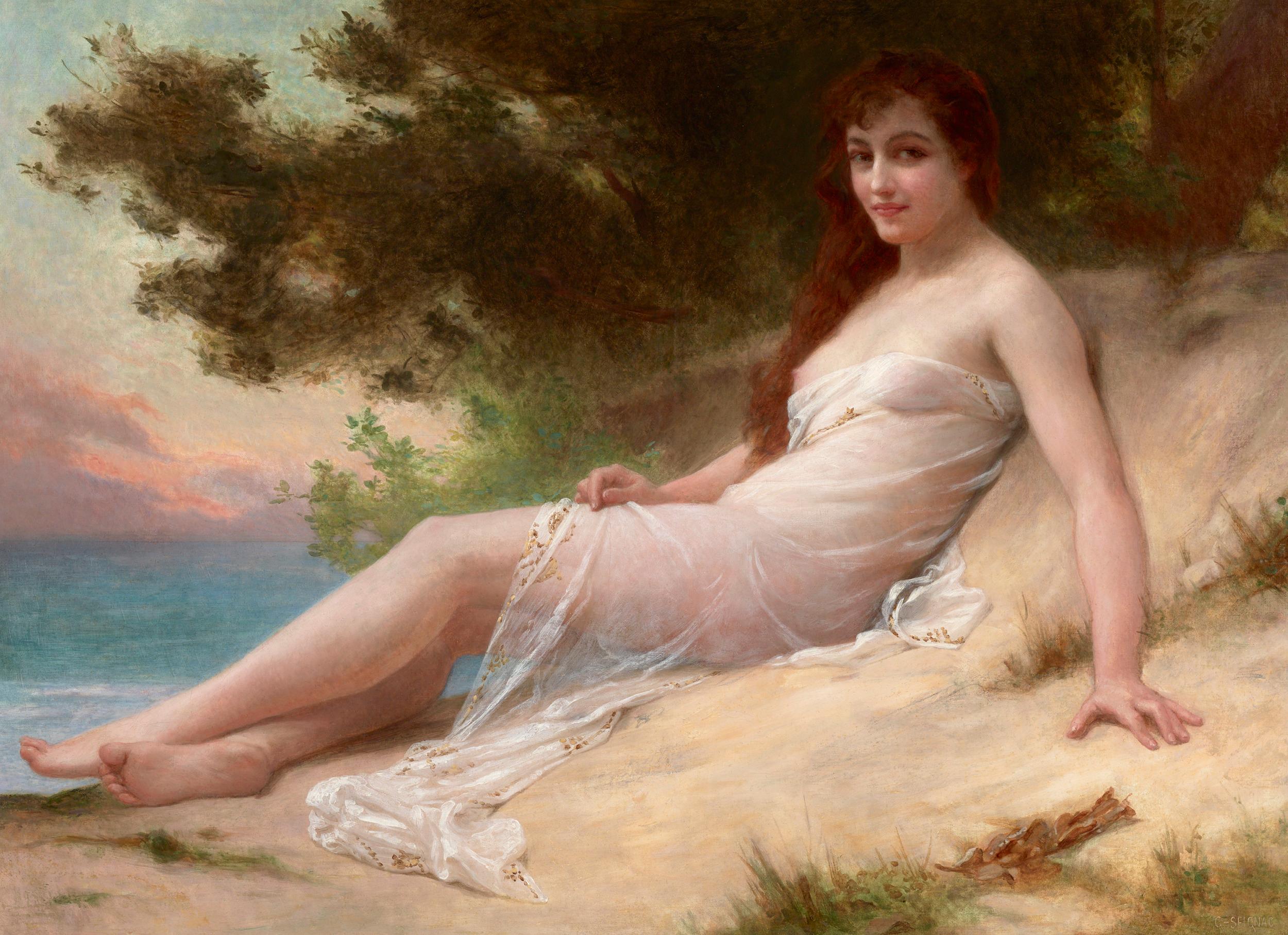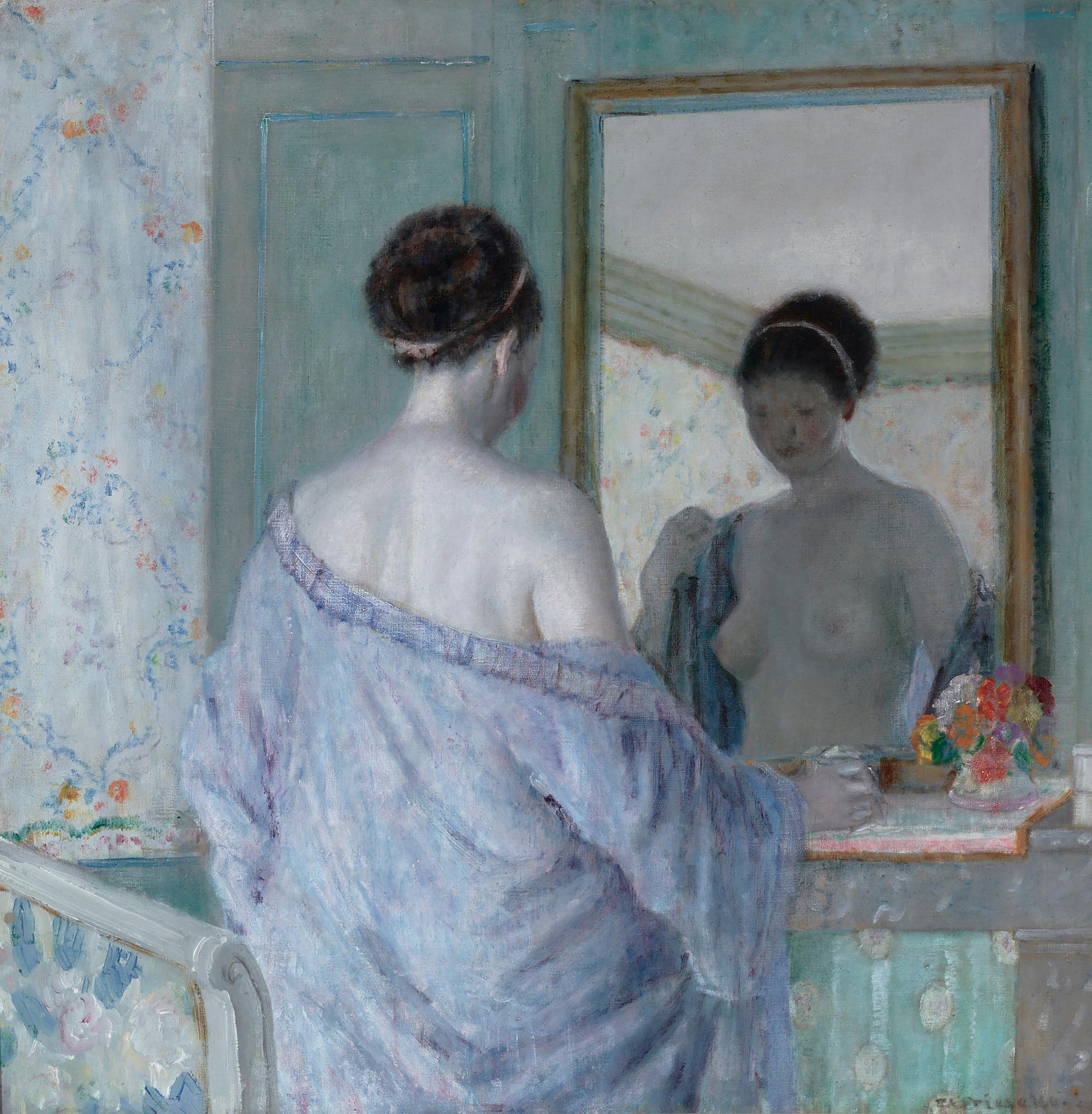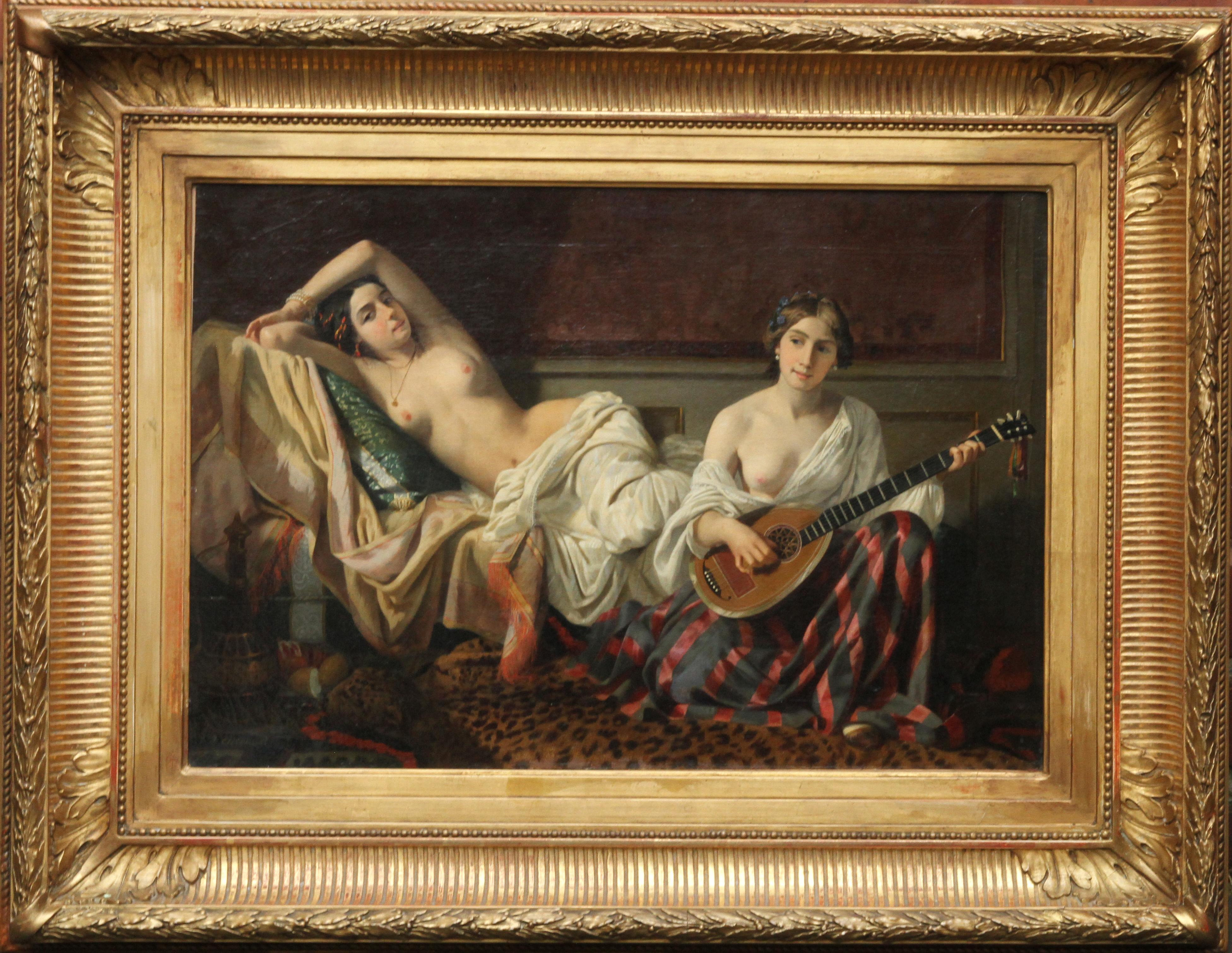Items Similar to Salome
Want more images or videos?
Request additional images or videos from the seller
1 of 6
Marie Felix Hippolyte-LucasSalome1816-1918
1816-1918
About the Item
This compelling portrait of Salome was composed by the French painter Marie Felix Hippolyte-Lucas. While the celebrated artist's oeuvre is filled with bright and cheerful portraits of aristocratic women surrounded by florals, here he takes a different approach. Hippolyte-Lucas' Salome is simultaneously exotic and highly modern, rendered in a style that is both theatrical and bold. The monumental work's rich color palette is filled with gem-inspired hues that lend drama to the scene, highlighting the blatant sexuality of this legendary seductress.
Though Salome is not named in the New Testament, she has appeared time and time again in art and literature over the centuries, as both an innocent and a seductress. Her mother, Herodias, resented John the Baptist, who denounced her marriage to King Herod as unlawful. At one evening meal, Salome danced for King Herod and his guests. He was so entranced by her, that he swore to give her whatever she asked of him. At her mother's request, she demanded the head of John the Baptist on a platter. Hippolyte-Lucas portrays her here in the role of the remorseless seductress, standing proudly next to the severed head of her mother's enemy.
Born in 1854 in Rochefort-sur-Mer, Marie Felix Hippolyte-Lucas studied under the great French Academic painters Isidore Pils, Karl Lehmann and Évariste Luminais. He became primarily known as a figure and portrait painter, and his oeuvre is filled with bright portraits of aristocratic women. He began exhibiting at the Paris Salon in 1877 and continued to do so until the year before his death, early numerous award over the years. Also a celebrated muralist, he composed decorative paintings for the casino in Monte Carlo, the conference centre at the Musée Océanographique in Monaco, the Paris Stock Exchange and three ceilings in the Préfecture du Rhône.
Canvas: 76 3/4" high x 38 1/4" wide
Frame: 82 3/8" high x 43 5/8" wide
- Creator:Marie Felix Hippolyte-Lucas (1854 - 1925)
- Creation Year:1816-1918
- Dimensions:Height: 82.38 in (209.25 cm)Width: 45.63 in (115.91 cm)
- Medium:
- Period:
- Condition:
- Gallery Location:New Orleans, LA
- Reference Number:
About the Seller
5.0
Vetted Seller
These experienced sellers undergo a comprehensive evaluation by our team of in-house experts.
Established in 1912
1stDibs seller since 2013
14 sales on 1stDibs
Typical response time: 3 hours
- ShippingRetrieving quote...Ships From: New Orleans, LA
- Return PolicyThis item cannot be returned.
More From This SellerView All
- SolitudeBy Guillaume SeignacLocated in New Orleans, LASigned “G-Seignac” (lower right) Oil on canvas French Academic painter Guillaume Seignac was renowned for his masterful treatment of the idealized nude. His languishing female subje...Category
19th Century Academic Nude Paintings
MaterialsOil, Canvas
- At the MirrorBy Frederick Carl FriesekeLocated in New Orleans, LAthe most important American Impressionists of his age. While many of his contemporaries focused on the landscape, Frieseke gained his inspiration from the figural, and in particular the theme of femininity. His works capture female figures engaging in traditionally feminine roles — strolling in the garden or posed in a domestic interior. At the Mirror...Category
Early 20th Century Impressionist Nude Paintings
MaterialsOil, Canvas
- SolitudeBy Guillaume SeignacLocated in New Orleans, LAFrench Academic painter Guillaume Seignac was renowned for his masterful treatment of the idealized nude. His languishing female subjects based on Greco-Roman prototypes were and rem...Category
19th Century Academic Nude Paintings
MaterialsOil, Canvas
- Orientala By Reuven RubinBy Reuven RubinLocated in New Orleans, LAReuven Rubin Israeli | 1893-1974 Orientala Signed “Reuven Rubin" Oil on canvas A striking and unique work rendered in a breathtaking jewel-toned palette, Orientala by Rueven Rubin...Category
20th Century Post-Impressionist Nude Paintings
MaterialsOil, Canvas
- Partial Coverage By Gil ElvgrenBy Gil ElvgrenLocated in New Orleans, LAGil Elvgren 1914-1980 American Partial Coverage Signed “Elvgren” (lower right) Oil on canvas The iconic illustrations of Gil Elvgren have become an irreplaceable facet of the American artistic landscape. Flirtatious beauties in light-hearted situations were the dominant subject matter for this intuitive artist, whose eloquent brush strokes dutifully captured the innocent sensuality of the mischievous girl next door. Partial Coverage, originally published in the 1956 Brown & Bigelow calendar, epitomizes the coquettish spirit of his beauties, whose nostalgic glamor give us a glimpse into a simpler time in American history. Elvgren is considered to be the greatest American pin-up and glamor artist. The majority of his work was done for the famed Brown & Bigelow, though at various points in his career he also worked for magazines such as The Saturday Evening Post and Good Housekeeping, as well as large corporations including Sealy Mattresses, General Electric and Coca-Cola. Born in St. Paul, Minnesota, Elvgren began his artistic education at the Minneapolis Art Institute, and later the American Academy of Art. His first job upon graduation was at the Chicago advertising firm of Stevens and Gross, working directly under Haddon Sundblom, famous for his Coca-Cola Santas. Elvgren would soon become his star pupil, contributing much to the Coca-Cola campaigns and eagerly learning techniques that he would carry into his famed pin-ups. After completing several special commissions with rave reviews, Elvgreen began doing pin-up work in 1937 for the Louis F. Dow Calendar Company, the biggest retailer of calendars of its day. Almost overnight, the artist became one of the most respected and successful commercial artists of his generation. More commissions followed, and, along with his work for Dow, Elvgren found himself booked solid at least one year ahead of his output. It was in 1944 that Brown & Bigelow approached him with an offer for a staff position. From that point on, for the next 30 years, Elvgren enjoyed tremendous commercial success unlike any other American artist of his day. Circa 1956 Canvas: 30 1/8“ high x 24 1/8” wide Frame: 33 3/4“ high x 27 7/8” wide x 1 1/2“ deep Literature: Charles G. Martignette and Louis K...Category
20th Century Figurative Paintings
MaterialsCanvas, Oil
- The Bather by Childe HassamBy Childe HassamLocated in New Orleans, LAChilde Hassam 1859-1935 American The Bather Signed and dated “Childe Hassam” (lower right) Oil on canvas Considered by many to be America’s foremost Impressionist painter, Childe Hassam composed his tranquil and intimate oil on canvas The Bather in the early years of the 20th century. The creation of the artwork aligns with a period of Hassam’s career where the artist’s palette was transforming, matching ever closer with the pale and pastel hues of French Impressionists like Claude Monet. Even the subject — a nude woman — represents a greater alignment with the Impressionist project, as artists of the movement and their non-mythological and non-biblical nudes still generated cries of indecency. With Hassam’s signature brushwork and attention to color, The Bather serves as a dream-like vision, serene and sensuous, of a young woman bathing in a lush forest. While the artist's skill for landscape painting is on display, it is Hassam's command of form, light and color that brings this canvas to life. He creates a captivating composition, placing the nude subject in the bottom left of the canvas. The soft, undulating curves of the woman's body in contrapposto and the glow of her fair skin are balanced by the strong verticals and deep earth tones of the tall trees to her right. Hassam delicately frames the nude in the vivid blues of the distant water, building luminous color that further draws the viewer’s eye and results in a somewhat voyeuristic appeal — endowing his nude with both a natural innocence and an intentional sensuality. Born in Dorchester, Massachusetts, Childe Hassam began his artistic career as a freelance illustrator, working for national publications such as Harper’s Weekly, Scribner’s Monthly, and The Century. His first solo exhibition of watercolors took place in Boston in 1883, and he quickly catapulted onto the international scene, winning a bronze medal at the Exposition Universelle in Paris in 1889. The year before the present work was created, he received the Webb Prize from the Society of American Artists for another landscape painted at Gloucester. Hassam would receive numerous other awards throughout his career, most notably the Gold Medal for Distinguished Services to Fine Art from the American Dealers Association. A true master, Hassam depicted a way of life characteristic of both American and French society, and his work elucidates a critical chapter in American art history. Today, his work resides in the Oval Office of the White House and in numerous important museums, including the Metropolitan Museum of Art in New York, the National Gallery of Art in Washington, DC and the Museum of Fine Arts in Boston, among others. This painting will be included in Stuart P. Feld's and Kathleen M. Burnside's forthcoming catalogue raisonné of the artist's work. Circa 1905 Canvas: 24 1/2“ high x 20 18” wide Frame: 35 7/8“ high x 31 1/4” wide x 3 1/4“ deep Provenance: Private Collection of William Young...Category
20th Century Impressionist Nude Paintings
MaterialsOil, Canvas
You May Also Like
- Model undressingLocated in BELEYMAS, FRJulius EXNER (Copenhagen, 1825 - Copenhagen, 1910) Model stripping Oil on canvas H. 122 cm; L. 74 cm Signed and dated 1842 lower right Exhibition: most likely Charlottenborg Salon of 1845, under number 110, titled Modelfigur, awarded with a silver medal Provenance: Emilio Fernando Bolt (c.1860 - 1944), acquired from the artist around 1900, then by descent Our painting was produced as part of the summer sessions organized between 1839 and 1850 by Christoffer Wilhelm Eckersberg (1783-1853), the master of Danish painting of the first half of the 19th century, in his private studio-apartment on the ground floor. floor at the Royal Academy of Fine Arts in Copenhagen. The master brought together a few students there between June and September, rented one or two models for the season, which were painted from different angles, the artists (including Eckersberg himself) sitting side by side. Eckersberg used to paint a fairly small version, the pupils of the larger formats. The work fits more generally into the legendary context of the research and reforms carried out by Eckersberg concerning the studies of nudes and in particular of female nudes, to make this exercise a genre of painting in its own right. Following his two-year stint in Jacques-Louis David's studio in Paris in 1811, Eckersberg had been made aware of work on the nude and in particular on live models, in natural light, while in Denmark the drawings were then only made from casts of antique models or other mannequins. In 1822, when he had been a professor there since 1818, it was he who had the Royal Academy of Copenhagen authorize the study of nudes, no longer in the evening by candlelight, but in natural light; from 1833, it was still he who allowed students to work on nude female models, even if the official authorization of the Academy did not take place until 1839. It was this same year that he instituted his summer sessions, on a private basis, to orient his painting and that of his students towards a new conception of the representation of models: even if the nude remains the real theme, it does not however, this is more than just an academic exercise. The subject is placed in a contemporary interior, with a rather sophisticated decor, and occupied with an intimate activity (it is this type of intimate vein that we will find later in Degas or Cassatt for example); thus in our painting, the young woman is supposed to take off her clothes to wash. The objective is that the viewer forgets that the master and his students are painting a model during a posing session, and that he instead has the impression of being alone with the model, but invisible, almost like a voyeur in spite of himself. Moreover, in these paintings, the model never looks towards the spectator, inducing a psychological distance with him, whereas model and artist are actually physically very close. On the other hand, it is not a question of idealized nudes either, even if Eckersberg, proof of his debt to the antique, chooses fairly classic models and poses. The sensuality is real and very present, with dreamy, even innocent, and timeless expressions (the models do not seem to have a defined age), suave and slow attitudes and movements, and especially with clothes that hide or reveal skillfully parts of the female body: upper buttocks, pronounced hips... Made by an artist under 20, our sensual painting is probably one of the most beautiful and spectacular produced by the students of Eckersberg during these summer sessions. With a perfect balance between the firmness of an ancient statue (it recalls the Venus de Milo) and the softness of the feminine forms, highlighted by a harmonious palette, it captures the attention with many details: the almost photographic folds white clothing...Category
1840s French School Nude Paintings
MaterialsCanvas, Oil
- Serenade in the Harem - French 19th Century Orientalist art nude oil paintingBy Joseph CaraudLocated in London, GBThis beautiful French 19th century Orientalist oil painting is by noted French artist Joseph Caraud. It was painted circa 1848 when Caraud was painting Algerian scenes. The compositi...Category
19th Century Realist Nude Paintings
MaterialsCanvas, Oil
- Nude woman oil on canvas paintingLocated in Barcelona, BarcelonaMaría Rosa Arsalaguet (1922-2003) - Female nude - Oil on canvas Oil measures 86x65 cm. Frameless. painter. He specialized in religious themes, still lifes and flowers. He participa...Category
1960s Post-Modern Nude Paintings
MaterialsOil, Canvas
- Chinese Contemporary Art by Jia Yuan-Hua - Mosaic, IfBy Jia Yuan-HuaLocated in Paris, IDFArtwork unframed 60 x 50 x 3 cm What are people's criteria for judging beauty? A beautiful face? A different existence? A feeling of pleasure? Or just follow what others say and make yourself feel the same way? People say the Winged Victory is very beautiful. Admirers come to the Louvre from all over the world. A lot of them just to take a picture to prove they saw it and say to friends, look, this is Winged Victory, how beautiful! Is it really that beautiful in her mind ? not necessarily. If it has head, do you still think it is beautiful? I am afraid many people will have a negative opinion. What is it that blurs the eyes of human beings and makes people's judgments of beauty vary widely? The painting uses knife...Category
2010s Contemporary Nude Paintings
MaterialsCanvas, Oil
- Entanglement in Red and Blue- 21st Century Contemporary Portrait of a womanLocated in Nuenen, Noord BrabantAlejandro Casanova Entanglement in Red and Blue 130 x 89 cm oil on canvas The Spanish artist Alejandro Casanova lives and works in Tenerife, where ...Category
2010s Contemporary Portrait Paintings
MaterialsCanvas, Oil
- Playing around- 21st Century Contemporary Portrait of a womanLocated in Nuenen, Noord BrabantAlejandro Casanova Playing around 100 x 100 cm oil on canvas The Spanish artist Alejandro Casanova lives and works in Tenerife, where he moved afte...Category
2010s Contemporary Portrait Paintings
MaterialsCanvas, Oil
Recently Viewed
View AllMore Ways To Browse
French Academic
Women Nude Paintings
Women Paintings Nudes
Painting Of Nude Women
Paintings Of Nude Women
Antique Roles
Nude Paintings Of Women
New Testament
Oeuvre Antique
Nude Mother
Antique Exchange
Nude Women Oil Painting
Nude Dancer Painting
Nude Dancing Painting
Oil Paintings Of Nude Women
The Antique Exchange
Nude Oil Women
Monumental 19th Century Painting




